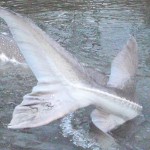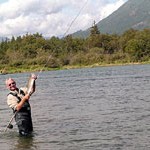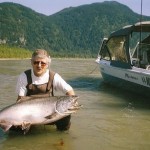Sturgeon Fishing Guide To Releasing
 The majority of white sturgeon populations in British Columbia are listed under the federal species at risk act and are open to angling. Since the populations in the lower and middle Fraser river are relatively healthy, they are able to support exciting world class fishery. How ever, these populations are still vulnerable to impacts from angling, habitat destruction, pollution and salmon net fisheries, and they are still provincially and nationally designated as endangered. In addition to being endangered, white sturgeon mature after 17 to 20 years and can live for more then a 100 years, so impacts or injuries can be long lasting. As such all sturgeon angling in the province is catch and release only and will be more strictly managed in the future. Indications are that catch and release sturgeon can be a low impact activity. However, to minimize harm to fish, extra care and attention must be taken to ensure there health and survival, and to maintain this treasure fishery. Anglers should abide by the following capture and handling practices:
The majority of white sturgeon populations in British Columbia are listed under the federal species at risk act and are open to angling. Since the populations in the lower and middle Fraser river are relatively healthy, they are able to support exciting world class fishery. How ever, these populations are still vulnerable to impacts from angling, habitat destruction, pollution and salmon net fisheries, and they are still provincially and nationally designated as endangered. In addition to being endangered, white sturgeon mature after 17 to 20 years and can live for more then a 100 years, so impacts or injuries can be long lasting. As such all sturgeon angling in the province is catch and release only and will be more strictly managed in the future. Indications are that catch and release sturgeon can be a low impact activity. However, to minimize harm to fish, extra care and attention must be taken to ensure there health and survival, and to maintain this treasure fishery. Anglers should abide by the following capture and handling practices:
- Angling tackle should be heavy enough to handle these potentially large fish. Use heavy rods and reels, and at least 100lb test line. Play and release fish as rapidly as possible. A fish played for to long may not recover.
- Only barb less hooks are promited while sturgeon angling, so hooks are easily removed. Well embedded hooks can be removed with long needle-nose pliers, or a hook remover. Grab the bend of the hook and twist, and the hook will dislodge. Be quick, but gentle. A fish that is deeply hooked, hooked on or near the gills, or bleeding profusely has a much lower chance of survival once released. You can improve its chances by cutting the leader and releasing the fish with the hook left in. The line will rot and the hook will eventually fall out.
- Leave the fish in the water wherever possible. A fish suffocates when its out of water, and is more at risk of internal injuries do to its own weight, especially if it is large (greater then 1.5 m in length).
- Land larger fish in shallow water near the shore. Do not drag any fish onto the shore or out of the water. Do not land a large fish at the boat and then tow it by the tail to shore. Towing a fish to the shore is very damaging to the fish and can lessen ‘chances of survival or even kill it. If you land a large fish at the boat, then release it at the boat. Smaller fish can be landed on the boat by lifting and cradling it with gloved hands underneath and behind the front fins and just forward of the tail. It should be placed into a wetted sling. A fish should never be pulled into a boat using a rope or by its gill plates, mouth or pectoral fins. Use as many people to cradle the fish as is necessary not to hurt it.
- If you handle a fish, then do so with care. Keep your fingers away from its gills and out of the gill plates, and don’t squeeze or hug the fish. If you want photographs then leave a larger fish in the water, smaller fish should be cradled. Have your camera ready and be quick so the fish is only briefly disturbed. Take the time to hold the fish in the water to recover. Point the fish up stream in the current while reviving it, and when the fish begins to struggle and swim normally, let it go.

